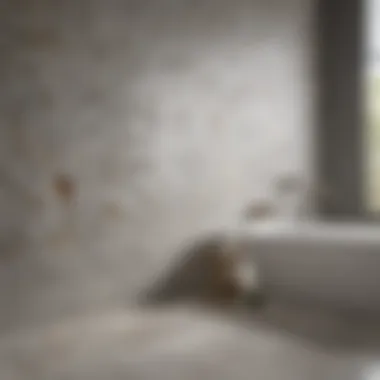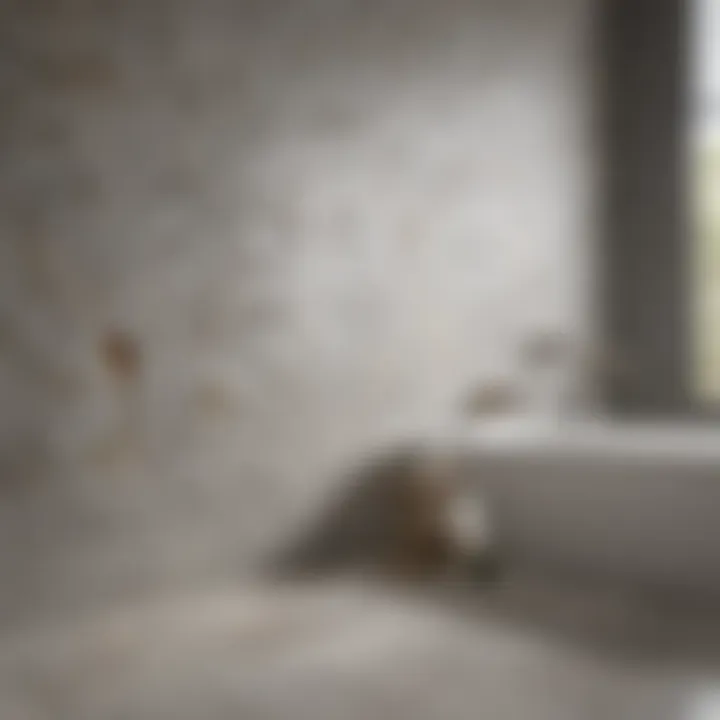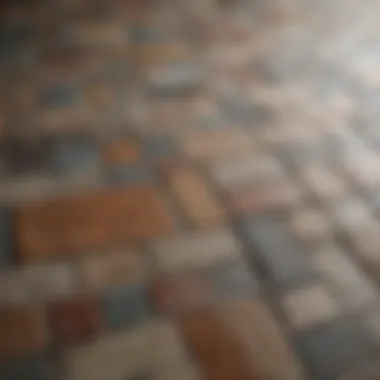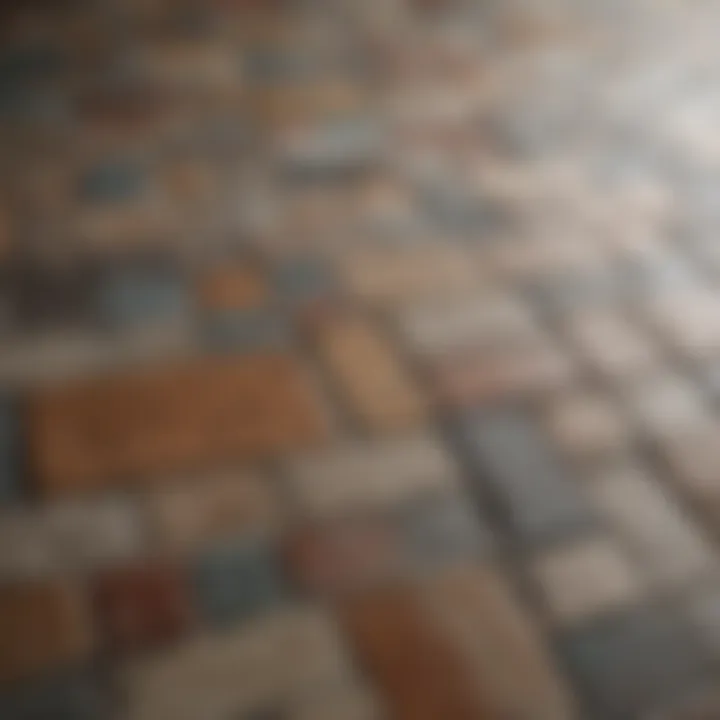Mastering the Grouting Process for Bathroom Tiles


Intro
Grouting tiles in bathrooms is not merely a task, but an art form that holds the potential to transform the atmosphere of a space. This intricate process requires careful consideration of material, technique, and aesthetic choice. Understanding the deeper layers of grouting goes beyond just filling in the gaps between tiles. It's about achieving a balance of beauty and function, ensuring that every line is as precise as a painter's stroke while standing the test of time.
Proper grout application can be the difference between a bathroom that looks like a well-designed haven and one that feels disjointed and haphazard. One could liken it to the canvas of a masterpiece; without the right strokes, the image remains incomplete and uninspired. As homeowners embark on the journey of tiling or renovating, the importance of this preparation cannot be overstated. A well-executed grout job does not just enhance the visual appeal but also plays a crucial role in preventing moisture buildup, which can lead to more severe issues over time.
In this article, we will explore the many possibilities that grouting offers, from the different types of grout available on the market to the essential techniques that will ensure a flawless finish. We’ll also highlight some common pitfalls encountered during the grouting process and impart practical tips to help both DIY enthusiasts and seasoned professionals avoid them. Get ready to dive into a comprehensive guide that will equip you with the knowledge to elevate your bathroom tile design to new heights.
Understanding Grout and Its Importance
Grouting tiles in bathrooms is more than just a finish touch; it’s an essential part that upholds the integrity and longevity of tiled surfaces. Grout may seem like a minor detail, but understanding it is crucial for both aesthetic appeal and practical application. When installed correctly, grout not only enhances the beauty of the tiles but also acts as a barrier against moisture, dirt, and debris, ensuring that your bathroom remains sleek and functional.
Defining Grout
Grout is a thick paste used to fill the spaces or joints between tiles, usually made from cement, water, and pigments. In its simplest form, it’s a mix designed to bind tiles together while providing support. Some may refer to it in a broader sense, encompassing various types that suit different tile materials, moisture levels, and aesthetic preferences. In the simplest terms, grout can be thought of as the glue that keeps your tiled surfaces intact.
Functions of Grout in Tile Work
The role of grout transcends its binding capability. Here are its key functions:
- Moisture Protection: Grout fills the gaps to prevent water from seeping behind tiles, which is vital in bathrooms where humidity levels are consistently high.
- Structural Support: Each joint of grout reinforces tile alignment and stability, providing a solid backing that can endure weight and daily stress.
- Aesthetic Element: Grout contributes significantly to the visual harmony of your tile installation, allowing for color coordination that can amplify or soften the appearance of your tiled space. The right grout choice can transform the look of a bathroom completely.
- Preventing Dirt Build-Up: Properly applied grout minimizes the chances of food particles, soap scum, and stains accumulating between tiles, making cleaning easier and quicker.
"A well-grouted tile isn’t just a pretty face; it’s the sturdy backbone of your tiled surfaces."
Moreover, selecting the correct type of grout is essential. Each kind has its unique properties that cater to different scenarios. For instance, epoxy grout offers extra durability in high-moisture areas, while standard cement-based grout is a commonly used choice that balances cost and effectiveness. Understanding these differences can save homeowners time and money, while also preventing headaches associated with improper installations.
In summary, knowing grout’s essential characteristics and functions can significantly enhance the outcome of your tiling project. It’s a detail that should never be underestimated; in practical terms, it protects your investment, and aesthetically, it brings your vision to life.
Types of Grout Available for Bathrooms
In every bathroom renovation, selecting the right grout can make or break the finish. Grout serves both aesthetic and functional purposes in tile work. Depending on the specific needs of the space, each type of grout offers distinct advantages and disadvantages. It’s essential for homeowners to grasp these options thoroughly to make an informed choice that will enhance both durability and visual appeal.
Cement-Based Grout
Cement-based grouts are a mainstay in tile installation, prized for their accessibility and overall effectiveness. They generally provide strong adhesion and are available in both standard and modified forms, which caters to varied project needs. Understanding the nuances between these two types can be vital for achieving the right balance of cost, performance, and finished look.
Standard Cement Grout
Standard cement grout is often favored for its straightforward application and reliability. This type is made from a mixture of cement, water, and sometimes sand. A key characteristic of standard cement grout is its tendency to shrink slightly as it cures, which can lead to hairline cracks under certain circumstances. However, its affordability makes it a popular choice for larger projects where cost-effectiveness is crucial.
One unique feature is its varied color options, which allow homeowners to coordinate with any tile design. Its main advantages include ease of use and availability, but the downside is that it may require sealing to prevent moisture absorption, which can compromise its longevity. In short, for those on a budget looking for a decent finish, standard cement grout does the job without fuss.
Modified Cement Grout
Modified cement grout stands a step above standard options in terms of performance and durability. It contains additional polymers that enhance its flexibility and bond strength, making it a suitable choice for areas subject to movement, such as bathrooms. This key characteristic means it’s less prone to cracking, providing a longer-lasting solution.
Many homeowners lean towards modified grout for its superior resistance to water and stains, which is vital in high-moisture environments. However, its price point tends to be higher than that of standard cement grouts, and it requires more careful mixing and application due to its specific handling instructions. Overall, modified cement grout is an excellent option for those prioritizing durability and longevity in their tile work.
Epoxy Grout
Epoxy grout is known for its robust performance, particularly in areas prone to spills and stains. This type is composed of a resin and hardener, creating a solid and water-resistant barrier that resists mold growth and discoloration. Epoxy grout is often considered a premium choice due to its exceptional durability, making it suitable for both commercial and residential applications.
What sets epoxy grout apart is its resistance to harsh cleaning agents and its long lifespan. While its initial cost might turn off some homeowners, the longevity and low maintenance required often makes it a worthwhile investment. However, it can be more challenging to work with, requiring skilled application techniques to avoid complications during installation.
Furan Grout
Furan grout, though less common, offers some unique properties that can be advantageous. Made from a synthetic resin, this type boasts incredible chemical resistance, which can be beneficial in specific applications such as laboratories or industrial settings. Its heat resistance also makes it a desirable choice where high temperatures are a consideration.
Furan grout is generally more complex to install, necessitating skilled hands to achieve good results. Many homeowners may find the learning curve steep, but its durability means it can outlast other types if properly applied.
Essential Tools and Materials for Grouting
Grouting tiles isn’t just a task; it’s an essential part of crafting a stunning and functional space in your bathroom. Having the right tools and materials at your disposal can make a world of difference between a botched job and a professional-looking finish. Here, we delve into the fundamental tools that every DIY enthusiast or homeowner should possess when embarking on a grouting project.
Grout Float
The grout float is arguably the unsung hero of tile installation. This tool is designed to apply grout smoothly and evenly across the tile surface. Its flat, rectangular shape allows you to push grout into the joints with precision. Unlike a spatula, a grout float has a sturdy rubber or foam bottom that grips the grout, making it possible to fill in those cracks without leaving a mess behind.


When using a grout float, hold it at a 45-degree angle for optimal performance. This angle minimizes the amount of grout that goes outside the joints. For bathroom tiles, where the lines can be particularly narrow and tricky, this tool is indispensable. Paying attention to the float's handle is also key; ensure it's comfortable enough for grip, as you might be working for an extended period. Don’t forget to clean the float after each use to maintain its effectiveness, as dried grout can be tough to remove.
Sponges and Rags
In any grouting job, sponges and rags play crucial roles. Sponges are used predominantly for cleaning up excess grout after you’ve applied it. Their porous nature helps absorb water, allowing you to wipe off any unsightly residues without scratching the tiles. A good quality sponge should be dense yet flexible, making it easier to maneuver around those corners and tight spots. Choose a sponge that’s specific for grouting; those large household sponges just won't cut it.
Rags, on the other hand, should be soft and lint-free. While sponges will handle the bulk of the cleanup, rags serve to achieve that final touch of cleanliness before the grout cures.
To get the best results, it’s wise to keep a mix of damp and dry rags handy during the grouting process. A damp rag helps to remove confusion without excessive water, while dry rags can be essential for achieving a polished look.
Bucket and Mixing Tools
When it comes to grouting, proper mixing is essential. Having a sturdy bucket and reliable mixing tools can save you a headache later on. A bucket should ideally be large enough to accommodate a full batch of grout without splatter. It can be tempting to use whatever is on hand, but a designated grout mixing bucket can avoid cross-contamination with other materials.
Mixing tools can vary but usually include a mixing paddle that attaches to a drill. This tool provides consistent mixing, ensuring all components—whether powder or liquid—combine smoothly without lumps. Pay careful attention to the manufacturer’s instructions regarding water-to-grout ratios. Too much water can weaken the grout, leading to cracking down the line.
Keep in mind, the way you mix your grout can affect the final finish. Mixing for the correct duration ensures uniform consistency, making application easier. Once you’ve mixed the grout, use it promptly before it begins to set.
Building a solid foundation with the right tools not only enhances the ease of your grout application but also can significantly affect the overall finish. Paying attention to these essentials will lead to a bathroom that not only looks great but is also resilient to the wear and tear of daily life.
Preparing the Surface for Grouting
When it comes to grouting tiles in bathrooms, proper surface preparation can’t be overstated. Not only does it lay the groundwork for a clean finish, it also significantly affects the durability and functionality of the tile installation. A well-prepared surface can help prevent future issues such as cracks, mold, or water damage, ensuring that your hard work stands the test of time.
Cleaning the Tile Surface
Cleaning the tile surface is the first step in preparing for grouting, and it’s often neglected. Think of it like a baker needing a clean countertop before rolling out dough. If tile surfaces are not spotless, any debris or grime will interfere with how the grout adheres.
Begin by sweeping up dust and debris, then follow with a thorough wash using a suitable tile cleaner. Be sure to rinse it well, as residues can impede grout adhesion. Additionally, if your tiles are textured, use a soft brush to get into the grooves. Avoid using harsh chemicals or abrasive scrubbing pads that could scratch the tile.
Key Points for Cleaning:
- Sweep and remove loose dust.
- Use a damp cloth or mop with a mild cleaner.
- Rinse thoroughly to eliminate any soap residues.
Inspecting Tile Alignment
Next, it’s important to assess tile alignment. An uneven installation can lead to aesthetic blemishes and may cause issues with grout application. When inspecting alignment, look closely at how tiles sit next to each other. Are the grout lines uniform? Are the tiles flush? If there are discrepancies, you may need to adjust them before grouting begins.
To check alignment, use a level. Place it on the tiles in various areas to identify any high or low points. If any adjustments are needed, now’s the time. It’s far easier to fix tiles now than after they’re grouted.
Alignment Considerations:
- Use a level to check uniformity.
- Adjust any misaligned tiles to ensure they sit even.
- Address height differences before applying grout.
Choosing the Right Grout Color
Selecting the right grout color can transform the overall look of your tiled area. It’s comparable to choosing a frame for a painting; the right color can enhance the aesthetic appeal while the wrong one can detract from it.
There are a few factors to consider. First, think about the color of your tiles. A contrasting grout can define the tiles and enhance their shapes. On the other hand, a similar color offers a more cohesive look. Additionally, you might want to consider the amount of traffic the bathroom gets. Lighter colors can stain easily, while darker shades may hide imperfections.
Take the time to get samples if possible. Apply the grout color on a small area and observe it in different lighting throughout the day. It’s a small step but can make a world of difference in the end result.
Tips for Choosing Grout Color:
- Consider contrast vs. cohesion with tile color.
- Factor in maintenance and potential staining.
- Test samples in various lighting conditions.
"A little preparation goes a long way in achieving a professional finish, particularly in areas like bathrooms where moisture is a constant factor."
In summary, preparing the surface adequately before grouting is a game-changer. From cleaning the tiles to checking their alignment and selecting the perfect grout color, each step contributes to the overall success of the project. House owners should treat these preparatory steps as essential, not optional, if they aim for a durable and visually appealing bathroom tile installation.
Grouting Techniques: Step by Step
Grouting is not just a final touch to tile work, but a crucial component in crafting a bathroom that blends beauty with practicality. Understanding proper techniques can save you time, ensure a flawless finish, and enhance the longevity of your tiles. Each step in the grouting process plays a pivotal role in achieving that desired look while preventing issues like cracking or mold growth. Being mindful and meticulous here pays off in spades.
Mixing the Grout


The first step in successful grouting is, unsurprisingly, mixing the grout. This sets the foundation for everything that follows. Whether you opt for cement-based or epoxy grout, getting the right consistency matters a lot. If it’s too thick, it won’t fill the lines adequately; too thin, and it may seep beneath your tiles, potentially causing problems later.
Mixing grout is usually straightforward. You generally combine dry grout powder with water following the manufacturer’s recommendations. Use a mixing bucket for ease, and don’t scrimp on the elbow grease; you want a smooth, lump-free mixture. Pay attention to the fact that premixed options can be convenient but might not offer the same strength as freshly mixed grout. This step is about striking a balance, ensuring you create a mix that is workable yet robust.
Applying the Grout
The real artistry comes into play when applying the grout. It’s vital to approach this methodically to cover all gaps without creating a mess. Here you must make use of a grout float, which is an essential tool for this process.
Using a Grout Float
The grout float serves as your primary tool for spreading the grout into the joints between tiles. Its firm, flat surface allows you to press the grout into place while minimizing the risk of causing uneven lines. Grout floats often come with a rubber or foam bottom which offers some give. This design is elegant in its simplicity; it allows the user to glide over the tile surface smoothly, pushing grout into even the narrowest of crevices.
The unique aspect of using a grout float is the angle at which it is held. A gentle tilt can help you avoid scraping the tile surface, thus preserving the tile’s shine and texture. Sometimes, though, you may have to reevaluate whether you feel comfortable with the float or if it might not be that strong against tile surfaces. Choose wisely, as this decision can affect the outcome heavily.
Working in Small Sections
Next, consider working in small sections. This technique is beneficial for a couple of reasons. First, it allows you to focus and manage the grout application without rushing through larger areas where the grout could dry prematurely. Second, it makes cleanup easier. When you break down the job into smaller chunks, you have a better handle over the working time.
A significant advantage to handling small stretches of tile is that you can pay closer attention to detail, ensuring every gap is filled correctly. You won’t feel pressured, and it’ll reduce the chances of error significantly. However, the downside may be the time it takes; if you're not accustomed to smaller segments, it could feel like you’re dragging your heels.
Cleaning Excess Grout
Once the grout is applied, a crucial part of the process is the cleaning up of any excess. Taking care of this ensures a polished appearance and prevents haze from forming on the tile surface.
Using a Damp Sponge
A damp sponge is your best friend here. The key lies in the technique; using a smooth, gentle touch is crucial to not disturb the grout you’ve already applied. You want enough water to moisten the sponge, but not so much that it pulls out the grout from the joints. This can be a fine line to walk, but the right balance will yield a clean tile surface.
The sponge should be rinsed often to avoid redepositing excess grout back onto the tiles. The feature that sets a damp sponge apart is its versatility—its ability to erase small mistakes while cleaning. Yet, keep in mind that a novice might end up using too much force, which can lead to messy lines along the edges.
Final Cleaning Techniques
After the bulk has been cleaned up, a final cleaning technique is essential for achieving that pristine finish. This step usually involves using a soft cloth or a specialized grout haze remover. The purpose here is to remove any remaining grout residue that the sponge may not have cleared away.
A notable characteristic of these final cleaning methods is their focus on maintaining the tile’s integrity while ensuring it sparkles. The unique method here is not just cleaning; it’s about preservation. Using the right technique can enhance the tiles’ appearance, making them more visually appealing. On the flip side, using aggressive scrubbing tools or harsh chemicals can mar your freshly installed tiles, leading to costly mistakes.
Always remember that an ounce of prevention is worth a pound of cure. Proper application and cleanup can prevent a multitude of headaches down the road.
By diligently following these steps, one ensures not only the aesthetic beauty of the tiled surface but also its long-term durability, making an investment that essentially pays for itself.
Post-Grouting Care and Maintenance
After the seemingly painstaking process of grouting tiles in your bathroom, it may be tempting to breathe a sigh of relief and think everything is done. However, this step marks the beginning of another crucial phase: post-grouting care and maintenance. How you treat your grout following installation can mean the difference between a finished surface that looks as good as new for years or one that quickly succumbs to unsightly wear and tear. In this section, we delve into the important steps to take and the reasons behind them, focusing on curing times, sealing, and regular maintenance practices.
Curing Time for Grout
One of the most critical yet often overlooked aspects of post-grouting care is allowing the grout to cure properly. Grout may feel dry to the touch shortly after application, but it requires adequate time to achieve its full strength and durability. Typically, grout will need about 24 to 72 hours to cure, depending on factors such as the type of grout used and environmental conditions in your bathroom.
Why is curing vital? A proper curing period enables the grout to bond with the tiles and the substrate beneath, preventing future cracking and crumbling. Premature exposure to moisture, heavy foot traffic, or cleaning can interfere with this process. Take the time to ensure that the area remains dry and undisturbed while the grout cures to get the best result.
Sealing Grout Lines
Once the grout has cured, it's time to apply a sealer. Sealing grout lines is essential for several reasons: it acts as a barrier against moisture, reduces staining, and helps prevent mildew and mold growth, making it particularly important in the damp environment of a bathroom.
The sealer should ideally be applied using a small paintbrush or roller, ensuring it penetrates the grout lines thoroughly. Depending on the product chosen, you may need to apply several coats. After sealing, allow it to dry completely according to the manufacturer’s instructions, typically 24 hours before exposing the surface to water.
Tip: Check the specific type of sealer recommended for your grout according to the instructions provided. Usually, there are two types: water-based and solvent-based, each with different application methods and drying times.
Regular Maintenance Practices
Lastly, keeping your grout looking pristine requires ongoing maintenance. Regular cleaning can go a long way in preserving both the look and integrity of your grout lines. Here are some best practices to keep in mind:
- Avoid Harsh Cleaners: Stick to pH-balanced cleaners designed for tile and grout. Harsh chemicals can erode your grout over time, weakening its structure.
- Daily Wiping: Use a damp cloth or sponge to wipe down the tiles after each use. This helps remove soap scum and prevents grime buildup.
- Annual Deep Cleaning: At least once a year, consider a thorough cleaning using a dedicated grout cleaner. This can help lift any stubborn stains that accumulate over time.
- Reapply Sealant: Depending on your bathroom's traffic and humidity, you might need to reapply the sealant every year or two to keep the grout protected.
By focusing on these post-grouting care practices, you not only ensure that your tiling job remains visually appealing but also extend the lifespan of your grout. A bit of prevention and regular upkeep can spare you from having to deal with costly repairs down the line.


Common Challenges in Grouting
Grouting tiles in bathrooms is a meticulous task that can transform a space from mundane to magnificent. However, it's not all smooth sailing, as there are several common challenges that can leave even the most seasoned DIY enthusiasts scratching their heads. Understanding these challenges is crucial because it allows homeowners to prepare adequately and avoid pitfalls that can diminish the aesthetic quality and longevity of their work. Grouting requires patience, precision, and, sometimes, problem-solving skills, ensuring that the investment in your home pays off over the long term.
Avoiding Grout Shrinkage
One of the most frustrating challenges faced during grouting is grout shrinkage. This phenomenon occurs when the grout mixture dries out too quickly, resulting in a noticeable gap between the tile and the grout line. Shrinkage often happens due to an improper mixing ratio or environmental factors. For instance, if the bathroom is too hot or dry, the grout may set faster than anticipated.
To mitigate this issue:
- Use Modified Grout: Modified cement grout contains additives that enhance its flexibility and minimize shrinkage.
- Control the Environment: If possible, keep the bathroom ventilated but not too dry during the curing process.
- Follow Manufacturer Guidelines: Always stick to the recommended water-to-grout ratios as specified on the packaging.
Here’s a tip: after applying the grout, cover it with a damp cloth or plastic sheet to slow down the drying process. This will help in keeping your grout lines intact and looking sharp.
Managing Grout Haze
Grout haze can be another pesky issue that arises when the cured grout leaves behind a cloudy film on the surface of the tiles. It’s typically the result of excess grout being left on the surface during application and can be particularly stubborn to remove. If not treated, grout haze can ruin the aesthetic finish of your tiling project.
To effectively manage grout haze, homeowners can:
- Act Quickly: Aim to clean off excess grout before it hardens. A simple damp sponge can do wonders at this stage.
- Use a Haze Remover: If the haze is already there, consider a commercial haze remover or a mixture of vinegar and water. Be sure to test it on a small area first to avoid damage.
- Follow Up with a Dry Cloth: After applying the haze remover, wipe down the surfaces with a dry cloth to restore the shine of your tiles.
"The difference between a good and a great finish often lies in the details. Haze removal is one small step that can make a big impact."
Addressing Cracks and Gaps
Cracks in the grout lines or gaps between the tiles can be a sign of improper installation or movement in the substrate. They can not only affect the overall look of your bathroom but also lead to water seeping behind tiles, which poses a risk for mold and mildew growth. Addressing cracks and gaps is vital for maintaining both the aesthetic and structural integrity of your tiling.
To effectively tackle this issue:
- Inspect Regularly: Make it a habit to periodically check your bathroom tiles for any signs of cracking.
- Reapply Grout If Necessary: If you spot significant cracks, it might be time to remove the old grout and apply a fresh layer. This ensures a tight seal and prevents water from penetrating.
- Consider Flexible Sealants: For areas prone to movement, consider using a flexible grout or caulking material designed for tile work. This can absorb any small movements without cracking.
Avoiding these common challenges is essential to achieving a professional look for your grouted tiles. By being proactive and knowledgeable about these issues, you can ensure a well-finished bathroom that remains beautiful for years to come.
Innovative Trends in Grouting
Understanding and embracing innovative trends in grouting can significantly enhance both the aesthetics and longevity of tiled surfaces in bathrooms. Today’s emphasis on design elements intertwines with functional durability, making it essential for homeowners and professionals alike to stay abreast of the options available. From vibrant color selections to environmentally-conscious materials, these developments not only brighten up spaces but also respond to the ever-growing demand for sustainability in home improvement projects.
Color and Texture Options
The range of colors and textures available for grout has expanded like a kid’s playground, opening a treasure trove of opportunities for customized bathroom designs. Once upon a time, grout was mostly a modest gray or beige—that’s changed.
- Dynamic Colors: Current trends include shades that pop. Think bold blues, soft pastels, and earthy tones. Homeowners looking to add pizzazz can opt for colors that contrast sharply with their tiles. This can create a stunning visual effect that really underscores tile patterns.
- Textures: Beyond color, texture plays a vital role. Textured grouts can provide additional grip and embody a tactile quality that smooth grouts lack.
- Epoxy Products: This particular type of grout offers excellent color retention and robustness, making it perfect for high-traffic areas or wet environments.
- Pattern Play: Using colored grouts to create patterns can enhance visual interest. Stripes or geometric designs in the grout can provide a sophisticated twist that catches the eye.
Remember: When choosing grout with vibrant colors, it’s always wise to test a small patch first on the wall before committing.
Eco-Friendly Grouting Solutions
In an age increasingly defined by eco-awareness, opting for eco-friendly grouting solutions is not just a trend but a responsible choice. As homeowners become more conscientious about their environmental footprint, manufacturers have responded by developing sustainable grout options that do not compromise on quality or performance.
- Materials: Some grouts are now formulated from recycled materials, which can significantly reduce waste. There is a growing variety of plant-based grouts, enriched with natural ingredients that provide superior durability and performance while being gentle on the planet.
- Low VOC Options: There are also strides toward producing grouts with low volatile organic compounds (VOCs), which contribute less to indoor air pollution and thus improve overall home health.
- Durability and Longevity: Eco-friendly grout often boasts improved resilience, leading to fewer repairs and replacements over the long run, further reducing waste.
- Water Conservation: Innovative products designed to require less water during installation align with sustainable practices, making the entire grouting process more environmentally friendly.
By integrating these trends—radiant colors that make a statement and sustainability that nurtures the planet—homeowners can achieve bathrooms that are not only visually appealing but also environmentally responsible. Keeping these options in mind ensures that the artistry of grouting transcends mere functionality to become an integral part of home design.
Ending
In wrapping up our exploration of grouting tiles in bathrooms, it becomes glaringly clear that this process is not just a finishing touch but a fundamental element of tile installation. Understanding the nuances of grouting contributes significantly to both the longevity and the visual appeal of your tiled surfaces. This article underscored several key elements, including the various types of grout options available, the importance of meticulous application techniques, and ongoing maintenance practices.
Recap of Key Points
To summarize, the critical aspects covered include:
- Types of Grout: Each type has its strengths—cement-based, epoxy, and furan grouts cater to different needs and environments.
- Preparation: The importance of a clean, level, and aligned surface cannot be overstated. A proper start simplifies the grouting process significantly.
- Techniques: Mixing and applying grout correctly is an art that requires attention to detail, while cleaning up properly is often where many go astray.
- Avoiding Challenges: Challenges such as shrinkage and haze can be mitigated with proper practices.
- Post-Care: Sealing and regular maintenance prolong the life of grout, preventing unsightly deterioration over time.
Final Thoughts on Grouting
Grouting may seem like a straightforward task, but it embodies a blend of science and art. The chemistry of the materials, the precise application techniques, and the personal touch all intertwine to create the finished look that you ultimately desire. As homeowners or DIY enthusiasts, recognizing the value of quality grouting should spur you on to invest time and effort into this integral part of your bathroom design.
"A well-grouted tile floor is not only functional but also invites a sense of completeness to your bathroom space."
Final thoughts would encourage readers to view grouting not as a chore but as an opportunity to express individuality through design choices. Take every step seriously, from selecting the right materials to executing the techniques correctly, and you will enjoy a bathroom space that stands the test of time.















